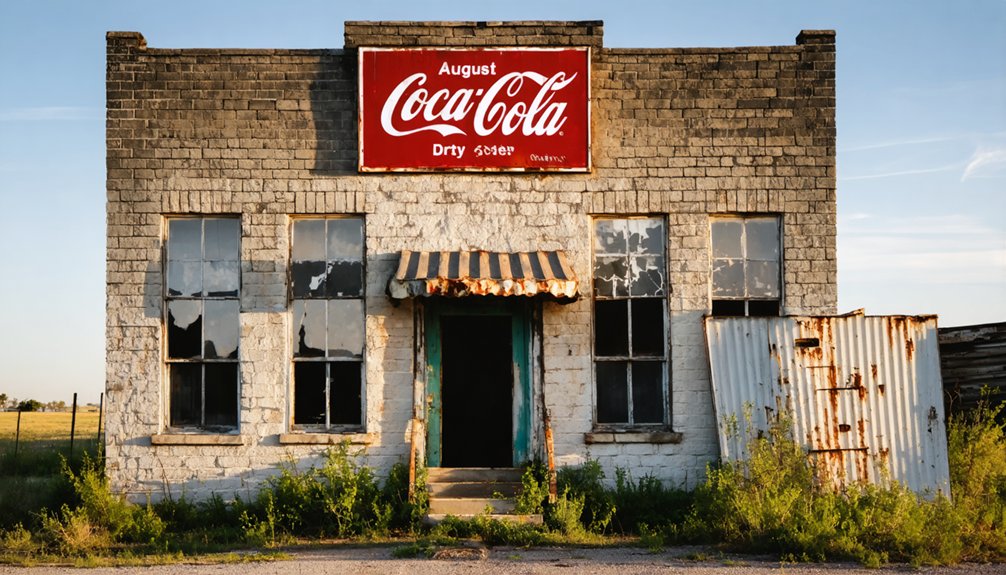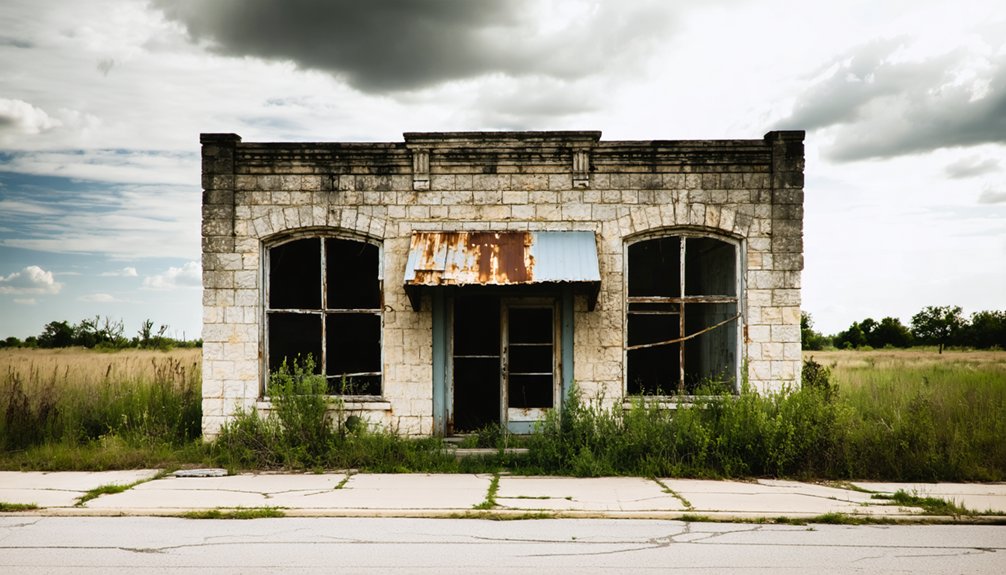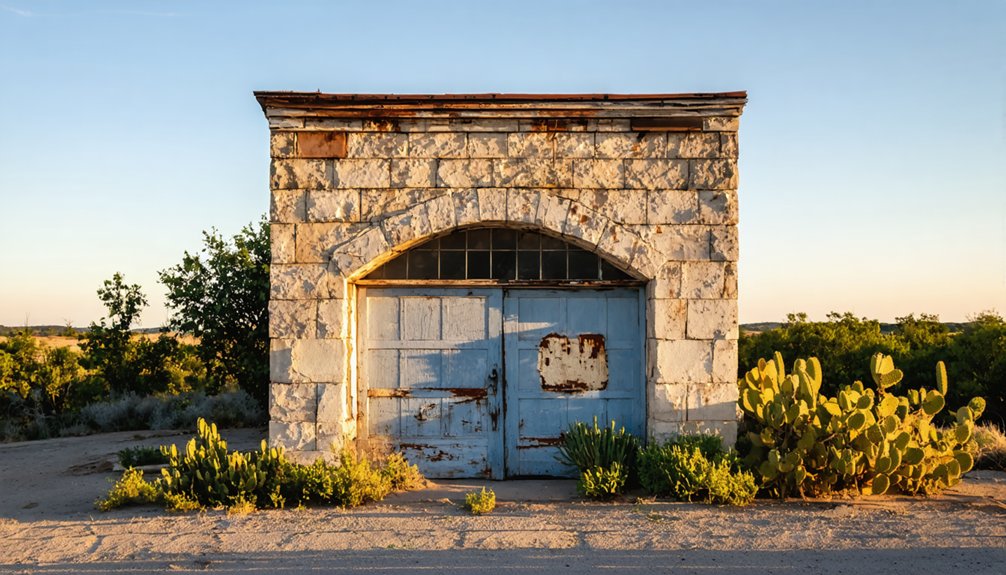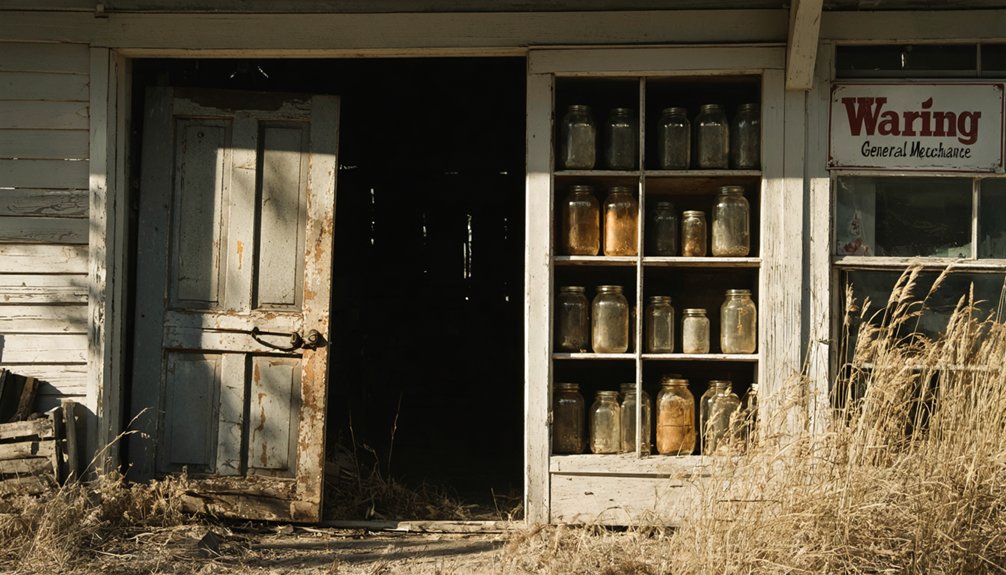You’ll find Waring in Kendall County, Texas, where the San Antonio and Aransas Pass Railroad established this frontier town in 1887. Originally named Waringford, it flourished with 275 residents, twice-daily train service, and August Offer’s bustling businesses including a store, saloon, and lumberyard. When rail service ended in 1913, the town declined but didn’t disappear entirely. Today, 60-100 residents maintain their quiet community amid historic structures that whisper tales of Texas Hill Country’s railroad era.
Key Takeaways
- Waring, Texas declined from a bustling railroad town of 275 residents in the 1890s to a small community of 60-100 today.
- The town’s decline began in 1913 when it lost its vital daily train service, severely impacting local agriculture and commerce.
- Historic structures remain standing, including the Toyah High School, W.W. Cole Building, and a Streamline Moderne Texaco station.
- Originally named Waringford, the town was established in 1888 as a transportation hub with twice-daily train service to San Antonio.
- While not completely abandoned, Waring maintains its historic character through preserved buildings and a small, close-knit rural community.
The Birth of a Railroad Town
When the San Antonio and Aransas Pass Railroad began surveying its route between San Antonio and Kerrville in 1887, a new town emerged along its path.
You’ll find its origins tied to R.P.M. Waring, an Irish immigrant from Waringford who donated the essential right-of-way for the railroad’s Kerrville line.
The town’s significance quickly grew as E.M. Burr planned its layout across 50 city blocks, creating a structured foundation for what would become a bustling transportation hub.
With twice-daily train service to San Antonio, Waring’s railroad significance transformed it into an important center of the region’s agricultural economy.
The town later gained additional rail importance when the San Antonio, Fredericksburg and Northern Railway connected through the area in 1913.
Farmers and merchants alike benefited from the new railway station, which would continue serving the community’s transportation needs for nearly eight decades. A post office was moved from the nearby town of Windsor, solidifying Waring’s position as a regional center.
From Waringford to Waring
You’ll find the origins of this Texas ghost town in its first name, Waringford, bestowed in 1887 to honor R. P. M. Waring, an Irish native who granted the essential right-of-way for the San Antonio and Aransas Pass Railroad.
Much like settler William Mingus who established his namesake town in 1856, R. P. M. Waring left an enduring legacy on the Texas landscape. The name was officially shortened to Waring in 1901.
The town’s official establishment came on February 23, 1888, when surveyor E. M. Burr laid out 50 city blocks and Richard Hunnam opened the first post office.
Origins Behind Town Names
The origins of Waring’s name trace back to R.P.M. Waring, who donated essential land for the San Antonio and Aransas Pass Railway in 1887. He memorialized his Irish hometown by naming the new Texas settlement Waringford, creating a lasting immigrant legacy through town naming practices common in the late 19th century. The small community grew to reach a peak of 300 residents in the early 1900s.
You’ll find the town’s identity deeply rooted in both transportation and personal history. When R.P.M. Waring provided the railway right-of-way and school grounds, he secured the community’s future as a significant hub. The town simplified its name to Waring in 1901, marking a new chapter in its development.
Railway Stop to Settlement
From its humble beginnings as a plotted railway stop in 1887, Waringford rapidly transformed into a bustling settlement along the San Antonio and Aransas Pass Railroad route.
R.P.M. Waring’s donation of the right-of-way from his Irish homeland sparked the town’s railway significance, leading to E.M. Burr’s ambitious layout of 50 city blocks.
You’ll find the transportation evolution reflected in the twice-daily train service to San Antonio, which spurred remarkable growth.
By the 1890s, the population reached 275, with August Offer’s entrepreneurial spirit driving development through his store, saloon, and lumberyard. The nearby town of Welfare experienced a similar peak of 275 residents during this prosperous railway era.
Like many semi-abandoned towns across Texas, Welfare remains inhabited but never regained its former vitality.
The 1888 post office establishment and construction of a dam-powered grist mill showcased the settlement’s progress.
The 1904 electric plant installation marked Waring’s transformation from a simple stop into a thriving commercial hub.
Golden Age of Commerce
During Waring’s prime years between 1888 and 1913, commerce flourished through three key developments: twice-daily rail service to San Antonio, August Offer’s diverse business enterprises, and robust agricultural processing facilities.
The town’s economic significance centered on Offer’s two-story cement block building, which housed retail operations and civic gatherings, while his dance hall and saloon became essential community hubs. Similar to the trade with Louisiana that enriched Spanish colonial merchants, these businesses created vital economic opportunities. The expansion of railroad networks across America proved critical for industrial towns like Waring to thrive and grow.
You’d have found a thriving agricultural economy supported by Offer’s dam-powered grist mill and cotton gin, while his 1904 electric plant brought industrial modernization to the region.
The post office and warehousing services facilitated trade, as local farmers shipped their goods to broader markets.
This golden age reflected the era’s spirit of community development, with local organizations regularly meeting in the upper rooms of Offer’s building, until the 1913 rail bypass triggered the town’s decline.
Life Along the Guadalupe River
You’ll find the old mill operations along Waring’s stretch of the Guadalupe River were central to the town’s early economic activity, with water-powered grist mills serving local farmers.
The river’s steady flow provided both practical and recreational value to Waring residents, who’d often fish and swim in its clear waters during the hot Texas summers.
The rocky limestone banks and gentle rapids near Waring made it a natural gathering spot for community picnics and social events throughout the late 1800s.
Early Mill Operations
Life along the Guadalupe River in Waring centered around three essential mill operations that powered the town’s early economy.
You’d find August Offer’s impressive dam construction, which harnessed the river’s force to drive both a grist mill and cotton gin, transforming local agriculture.
These operations weren’t just buildings – they were the lifeblood of the community, processing farmers’ grain and cotton right there in town.
River Recreation Activities
Beyond the mill operations that once defined Waring’s industrial character, the Guadalupe River beckoned residents and visitors with its recreational treasures.
You’ll find locals and tourists alike enjoying river tubing along the popular Horseshoe Loop, a two-hour float that showcases the region’s natural beauty. Kayaking adventures offer a different perspective, letting you paddle through calm waters while spotting native wildlife and waterfowl.
The river’s reputation as a premier fishing destination draws anglers year-round, especially during the winter months when the waters below Canyon Lake Dam teem with stocked trout.
Swimming holes, marked by emerald-green waters and shaded by towering cypress trees, provide perfect spots to cool off and unwind, while picnic areas along the riverbank invite you to make a day of your water-based adventures.
August Offer’s Business Empire

During the town’s heyday, August Offer built a formidable business empire in Waring, Texas, establishing multiple enterprises that became the economic backbone of this rural community. His keen eye for business diversification led him to venture into retail, agriculture, and various services.
You’ll find his legacy most prominently in the general store he operated, which served both locals and travelers passing through this strategic location.
Offer’s establishments weren’t just businesses – they functioned as essential community hubs where residents gathered to trade goods, share news, and strengthen social bonds. His ventures created jobs, attracted commerce, and helped Waring flourish beyond its ranching roots.
Through strategic adaptation to rural Texas’s evolving economy and commitment to reliable service, Offer’s business acumen transformed Waring into a significant regional destination.
Architecture Through Time
When you explore Waring’s architectural history, you’ll find a blend of simple wood-frame structures like the relocated 1878 one-room schoolhouse alongside more durable masonry buildings influenced by European craftsmen.
You can still spot remnants of the Methodist Church’s distinctive bell tower and original wooden pews that reflect the modest, functional style typical of rural Texas religious architecture in the late 19th century.
The town’s building practices were shaped by both practical needs and cultural influences, from Polish immigrant masons who brought their brick-laying expertise to the region’s characteristic barbed wire fencing that defined property boundaries and town layout.
Historic Building Materials Used
As Waring developed from its earliest settlements, the town’s architecture reflected a natural progression in building materials that matched both local resources and technological advances.
You’ll find that initial timber construction dominated the landscape, with locally sourced wood framing most single-story structures. The town’s growth brought significant changes, particularly in 1908 when August Offer introduced cement block construction, marking a shift toward more durable materials.
Industrial materials soon transformed the townscape, as evidenced by the mix of stone and concrete used in dam construction along the Guadalupe River.
Skilled Polish immigrants contributed their masonry expertise, creating fine brickwork between 1908 and 1913. These varied materials showcase Waring’s evolution from a simple settlement to a more developed community with diverse architectural needs.
Landmark Structures Still Standing
The architectural legacy of Waring’s heyday remains visible through several prominent structures that have withstood time’s passage. The town’s most significant landmark is the Toyah High School building, which stands as a symbol of early 20th-century educational architecture and is known for reported ghostly encounters within its preserved halls.
- The W.W. Cole Building showcases the town’s commercial architectural significance, having served as both a bank and pharmacy.
- A Streamline Moderne styled Texaco station represents the golden age of automotive travel, complete with its original rusty pumps.
- The historic post office structure remains intact, exemplifying the essential communication hubs that connected these remote Texas communities.
Several churches and industrial buildings also dot the landscape, their weathered walls telling stories of Waring’s vibrant past.
Architectural Design Influences
Throughout Waring’s development from the late 19th century into the early 20th century, distinct architectural influences shaped its built environment.
You’ll find E.M. Burr’s systematic grid pattern reflected the latest community planning principles of the era, while the town’s positioning along the Guadalupe River strategically integrated industrial and residential needs.
The architectural styles you’ll notice showcase a practical blend of local materials and skilled craftsmanship.
Cement block and brick buildings, like August Offer’s two-story structure, demonstrate how immigrant masons left their mark on the town’s character.
Multi-use buildings combining business, residential, and social spaces became a hallmark of Waring’s design approach, while industrial structures like the 1908 electric plant and river dams represented the town’s embrace of technological progress in its architectural evolution.
When the Trains Stopped Coming
During Waring’s early heyday, daily trains connected this small Texas town to San Antonio, stopping twice each day to serve the bustling agricultural community.
Steam engines thundered through Waring twice daily, breathing life and commerce into the small Texas farming town.
When the San Antonio to Fredericksburg line bypassed Waring in 1913, you could almost hear the town’s heartbeat slow. The loss of direct train service triggered an economic decline that would reshape Waring’s destiny.
- Local farmers lost vital shipping capabilities for their agricultural goods
- Merchants watched their customer base dwindle as passenger service disappeared
- Warehouses that once hummed with activity fell silent as freight traffic dried up
Like many Texas towns bypassed by railroads, Waring’s story reflects a broader pattern of rural decline.
The town’s transformation from a thriving rail stop to a quiet ghost town mirrors the fate of countless communities left behind when the trains stopped coming.
Historic Landmarks Today

Standing as silent sentinels to Waring’s vibrant past, today’s historic landmarks offer visitors a compelling glimpse into early 20th-century Texas life.
You’ll find the Waring Schoolhouse significance preserved in its traditional rural design, now a Texas Historic Landmark since 2000.
The cemetery’s cultural diversity reflects the town’s mining heritage through ornate headstones carved by immigrant stonemasons, particularly those of Polish and Italian descent.
Throughout the town, you’ll discover remnants of the mining era, including iron fencing, brick masonry, and abandoned company structures.
The weathered foundations and sealed mine shafts tell the story of boom-and-bust economics, while preserved houses and outbuildings showcase the architectural styles that defined this once-thriving community.
Modern-Day Community Life
Modern Waring offers a distinctive blend of rural Texas charm and contemporary Hill Country living. Though small in population, with roughly 60-100 residents spread across its rolling landscape, you’ll find a close-knit community that maintains its independent spirit while adapting to changing times.
Nestled in the Texas Hill Country, Waring preserves its small-town spirit while embracing modern life among rolling hills and friendly faces.
- Community gatherings often revolve around local traditions preserved by the 44 households that call Waring home.
- You’ll discover residents balancing rural serenity with convenient access to nearby Boerne’s amenities.
- The area’s affluent demographics reflect the broader Kendall County prosperity, though Waring retains its unpretentious character.
Daily life centers around the post office and familiar routes like Waring Welfare Road, where neighbors continue to write their own chapter in this historic settlement’s story, embracing both their heritage and future.
Preserving Texas Hill Country Heritage

As Texas Hill Country grapples with preserving its heritage, ghost towns like Waring serve as crucial links to the region’s past.
You’ll find these abandoned settlements increasingly threatened by population decline, aging landowners, and natural disasters that put their historic structures at risk.
Heritage preservation efforts are led by over 200 county historical commissions, but you can’t always access these sites due to private land restrictions.
If you’re interested in supporting preservation, you’ll discover various community engagement opportunities through local museums and historical boards.
The Texas Historical Commission‘s mission to “save the real places that tell the real stories of Texas” relies on active participation from people like you.
Despite the challenges, adaptive reuse success stories prove that with dedication, these important pieces of Hill Country history can survive for future generations.
Frequently Asked Questions
What Happened to the Original Waring Family After the Town’s Founding?
You won’t find clear records of the Waring legacy after the town’s founding. Historical documents don’t track the family descendants, suggesting they likely dispersed as the town declined from prosperity.
Are There Any Surviving Photographs of Waring During Its Peak Years?
You’ll find historical archives and photographic evidence of Waring’s peak years, though they’re limited. Check Texas Escapes and local collections for vintage black-and-white images of the town’s railroad era.
What Natural Disasters or Significant Weather Events Has Waring Experienced?
You’d have felt the impact of Central Texas’s notorious flood events and extended drought periods, just as 1921’s devastating regional floods and 2023’s record-breaking heat wave struck the Waring area.
Did Any Notable Crimes or Conflicts Occur in Waring’s History?
While you’ll find few documented major crimes specific to Waring, there were violent altercations typical of Texas frontier towns and mysterious disappearances that locals discussed, though details remain largely unconfirmed in historical records.
What Indigenous Peoples Inhabited the Area Before Waring’s Establishment?
Like ancient echoes across time, you’ll find the cultural heritage of three Native tribes in Waring’s past: the Tonkawa hunter-gatherers, Lipan Apache warriors, and powerful Comanche horsemen who controlled these lands.
References
- https://www.txgenwebcounties.org/kendall/warng.htm
- https://www.youtube.com/watch?v=PsuLwAQ12QI
- https://texashillcountry.com/weekend-wandering-in-waring-texas/
- https://www.texasescapes.com/MichaelBarr/Waring.htm
- https://en.wikipedia.org/wiki/List_of_ghost_towns_in_Texas
- https://texashillcountry.com/ghost-town-welfare-texas/
- https://www.tshaonline.org/handbook/entries/waring-tx
- https://www.texasescapes.com/TexasHillCountryTowns/Waring-Texas.htm
- https://www.abandonedrails.com/waring-to-fredericksburg
- https://en.wikipedia.org/wiki/Waring



